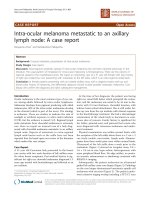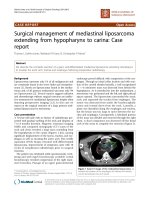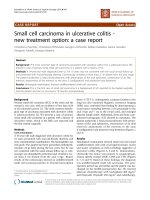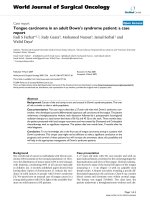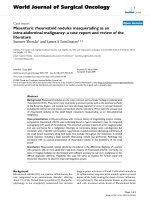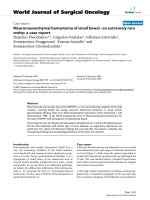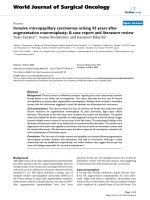báo cáo khoa học: "Severe bronchopulmonary dysplasia improved by noninvasive positive pressure ventilation: a case report" pptx
Bạn đang xem bản rút gọn của tài liệu. Xem và tải ngay bản đầy đủ của tài liệu tại đây (320.68 KB, 4 trang )
CAS E REP O R T Open Access
Severe bronchopulmonary dysplasia improved by
noninvasive positive pressure ventilation: a case
report
Christian Mann
1,2*
and Walter Bär
1,2
Abstract
Introduction: This is the first report to describe the feasibility and effectiveness of noninvasive positive pressure
ventilation in the secondary treatment of bronchopulmonary dysplasia.
Case presentation: A former male preterm of Caucasian ethnicity delivered at 29 weeks gestation developed
severe bronchopulmonary dysplasia. At the age of six months he was in permanent tachypnea and dyspnea and
in need of 100% oxygen with a flow of 2.0 L/minute via a nasal cannula. Intermittent nocturnal noninvasive
positive pressure ventilation was then administered for seven hours daily. The ventilator was set at a positive end-
expiratory pressure of 6 cmH
2
O, with pressure support of 4 cmH
2
O, trigger at 1.4 mL/second, and a maximum
inspiratory time of 0.7 seconds. Over the course of seven weeks, the patient’s maximum daytime fraction of
inspired oxygen via nasal cannula decreased from 1.0 to 0.75, his respiratory rate from 64 breaths/minute to 50
breaths/minute and carbon dioxide from 58 mmHg to 44 mmHg.
Conclusion: Noninvasive positive pressure ventilation may be a novel therapeutic option for established severe
bronchopulmonary dysplasia. In the case pre sented, noninvasive positive pressure ventilation achieved sustained
improvement in ventilation and thus prepared our patient for safe home oxygen therapy.
Introduction
Although there is some evidence that nasal noninvasive
ventilation has the potentialtoreducetheincidenceof
bronchopulmonary dysplasia (BPD) in preterm new-
borns [1 -5], there have been no studies of nasal nonin-
vasive positive pressure ventilation (NIPPV) in former
preterm infants with an established diagnosis of BPD
requiring high oxygen concentrations.
The main pathophysiological finding in BPD is a low
functional residual capacity accompanied by inefficient
gas mixing. Respiratory rate is increased [6]. Small air-
way function may worsen during the f irst year [7]. Sig-
nificant gas trapping is found in some BPD infants [8,9].
We report the response to intermittent nocturnal ther-
apy with nasal NIPPV in an infant with severe BPD.
Case presentation
Our patient was a male preterm of Caucasian ethnicity,
born at 29 weeks and one day gestation by Caesarean
section from a spontaneous dichorionic diamniotic twin
pregnancy complicated by preterm premature rupture of
the membranes with near-total loss of fluid nine days
before delivery. His birth weight was 940 g. A chest X-ray
showed pulmonary hypoplasia and grade 3 hy aline mem-
brane disease. Surfactant (be ractant 100 mg/kg) was
given one hour after birth and repeated 24 hours later.
The patient was started on high frequency oscillatory
ventilation, with highest mean airway pressure 22
cmH
2
O on day one, and then switched to pressure-con-
trolled synchronized intermittent mandatory ventilation
on day 20 (highest peak inspiratory pressure 24
cmH
2
O). Inhaled nitric oxide was delivered for five days
in decreasing amounts (starting on day one with 26
ppm).
A left pneumothorax was drained on day four. The
clinical course was complicated by ventilator-associated
pneumonia on day 15. Tracheal aspirates grew
* Correspondence:
1
Neonatal and Pediatric Intensive Care Unit, Graubuenden Cantonal Hospital,
Loestr 170, CH-7000 Chur, Switzerland
Full list of author information is available at the end of the article
Mann and Bär Journal of Medical Case Reports 2011, 5:435
/>JOURNAL OF MEDICAL
CASE REPORTS
© 2011 Mann and Bär; licensee BioMed Central Ltd. This is an Open Access article distributed under the terms of the Creative
Commons Attribution License ( which permits unrestricted use, distribution, and
reproduction in any medium, provided the original work is properly cited.
coagulase-negative Staphylococci and Enterobacter cloa-
cae. Treatment consisted of piperacillin and tazobactam
with fusidic acid for two weeks. Extubation was success-
ful on day 26 after a two-day course of dexamethasone.
Ventilatory support was continued with nasal continu-
ous positive airway pressure (nCP AP; 8 cmH
2
O). BPD
was diagnosed at postmenstrual age 36 weeks. Shortly
thereafter, nasal swab cultures from copious upper air-
way secretions proved colonizatio n with Stenotrophomo-
nas maltophilia, Escherichia coli as well as
Staphylococcus aureus which was treated with a two-
week course of oral sulfamethoxazole plus trimethoprim
and rifampin.
After 10 weeks nCPAP was switched to nasal cannula
flow of 2 L/minute with a fraction of inspired oxygen
(FiO
2
) of 0.5. Pulse oximetry target was set at arterial
oxygen saturation (SaO
2
) ≥ 90%. During subsequent
weeks the oxygen concentration had to be increased to a
FiO
2
of 1.0 due to progressive deterioration of gas
exchange. At the age of six months our patient was in
constant dyspnea and tachypnea. Spontaneous inspira-
tory time was markedly shortened. Streaky densities and
cystic areas on a chest X-ray confirmed the diagnosis of
severe BPD. Echocardiography revealed concomitant pul-
monary hypertension with a tricuspid regurgitation pres-
sure gradient up to 30 mmHg. The FiO
2
1.0 requirement
create d a high risk of urgent reintubation in the event of
sudden desaturation. The boy’s increasing drive to move
around ruled out reintroducing nCPAP.
A ventilator set to NIPPV was installed providing noc-
turnal ventilatory support for an average of seven hours
every night. Ventilator settings are presented in Table 1.
For the first 18 days, sedation was provided with chloral
hydrate in decreasing amounts from 52 mg/kg to 7 mg/
kg per evening dose.
The features of the NIPPV device included a limited
dead space, highly sensitive automated circuit leak com-
pensation, and high trigger sensitivity. NIPPV was admi-
nistered via a nasal mask in a semirecumbent position
to enhance air entry into West zones 1 a nd 2 and to
diminish expansion of the radiologically over-distended
lung bases.
In the course of seven weeks of intermittent nocturnal
NIPPV, the spontaneous respiratory rate decreased from
64 breaths/minute to 50 breaths/minute, morning (post-
NIPPV) carbon dioxide dropped from 58 mmHg to 44
mmHg, and–most important ly–nasa l cannula maximum
FiO
2
decreased from 1.0 to 0.75 and the minimum FiO
2
from 0.8 to 0.6 (Figure 1). At this point, NIPPV was
stoppedandthebabywasdischarged on home oxygen
(flow rate 0.25 L/minute) at the postnatal age of eight
months. His weigh t increased by 200 g per week during
NIPPV therapy and reached 7490 g at discharge.
Two intercurrent lower respiratory tract infections
were managed on an outp atient basis. Our pat ient was
completely weaned off oxygen nine months after dis-
charge at the age of 17 months.
Neurological examination at the age of one year
showed less delay in the mental scale than in the psy-
chomotor scale (Bayley II) with scores of 76 and 56,
respectively. Free walking was achieve d at 22 months of
age.
Conclusion
The clinical course of this ex-preterm boy suggests that
secondary NIPPV therapy has the potential to improve
severe BPD. A course o f nocturnal intermittent NIPPV
in a timely manner (seven weeks) improved ventilation
and reduced oxygen need to a degree which provided
sufficient safety for subsequent home oxygen therapy.
Its positive effect was essential for o ur patient’sdis-
charge after eight months of hospital stay. In terms of
practicability, NIPPV was superior t o nCPAP in that it
reliably avoided hypoventilation when the child initially
needed sedation to tolerate a nasal mask.
According to the literature, a bundle of different
mechanisms may have contributed to the improvement
observed. Synchronized NIPPV is known to increase
functi onal residual capacity [4], enhance ventilation uni-
formity [5], improve respiratory drive [10,11], lead to
greater lung recruitment [12] and decrease inspiratory
effort and respiratory work in comparison to continuous
flow nCPAP [13,14]. The duration of ventilatory support
is shorter with primary use of NIPPV than with nCPAP
[15].
We think this observation provides useful information
on N IPPV in established BPD before larger randomized
studies are performed on this topic. Further studies
incorporating lung function tests should identify the
level of respiratory support at which the repetitive sti-
mulus of nocturnal NIPPV exerts most of its positive
influence. It would be interesting to find out how
NIPPV propagates lung remodelling or if it even has the
potential to accelerate lung maturation in severe BPD.
Consent
Written informed consent was obtained from the
patient’s parents for publication of this case report. A
Table 1 Ventilator settings for NIPPV
Pressure support 4 cmH
2
O
Positive end-expiratory pressure 6 cmH
2
O
Trigger 1.4 mL/second
Ramp 25 ms
Expiratory trigger sensitivity 10%
Backup respiratory rate 8/minute
Maximum inspiratory time 0.7 seconds
Mann and Bär Journal of Medical Case Reports 2011, 5:435
/>Page 2 of 4
copy of the written consent is available for review by the
Editor-in-Chief of this journal.
Acknowledgements
The authors thank Axel Zolkos for his technical skills in administering
noninvasive ventilation to this infant and for his support in extracting
patient data from the chart.
Author details
1
Neonatal and Pediatric Intensive Care Unit, Graubuenden Cantonal Hospital,
Loestr 170, CH-7000 Chur, Switzerland.
2
College for Intensive Care,
Emergency and Anesthesia Nursing, Children’s Hospital, University Clinic,
Steinwiesstrasse 75, CH-8032 Zuerich, Switzerland.
Authors’ contributions
WB led the decision to institute NIPPV in this case. WB and CM analyzed
and interpreted the patient data. CM reviewed the literature and wrote the
manuscript. Both authors read and approved the final manuscript.
Competing interests
The authors declare that they have no competing interests.
Received: 18 April 2011 Accepted: 6 September 2011
Published: 6 September 2011
References
1. De Paoli AG, Davis PG, Lemyre B: Nasal continuous positive airway
pressure versus nasal intermittent positive pressure ventilation for
preterm neonates: a systematic review and meta-analysis. Acta Paediatr
2003, 92:70-75.
2. Kulkarni A, Ehrenkranz RA, Bhandari V: Effect of introduction of
synchronized nasal intermittent positive-pressure ventilation in a
neonatal intensive care unit on bronchopulmonary dysplasia and
growth in preterm infants. Am J Perinatol 2006, 23:233-240.
3. Kugelman A, Feferkorn I, Riskin A, Chistyakov I, Kaufman B, Bader D: Nasal
intermittent mandatory ventilation versus nasal continuous positive
airway pressure for respiratory distress syndrome: a randomized,
controlled, prospective study. J Pediatr 2007, 150:521-526.
4. Owen LS, Morley CJ, Davis PG: Neonatal nasal intermittent positive
pressure ventilation: what do we know in 2007? Arch Dis Child Fetal
Neonatal Ed 2007, 92:F414-F418.
5. Deakins KM: Bronchopulmonary dysplasia. Respir Care 2009, 54:1252-1262.
6. Hjalmarson O, Sandberg KL: Lung function at term reflects severity of
bronchopulmonary dysplasia. J Pediatr 2005, 146:86-90.
7. Hofhuis W, Huysman MW, van der Wiel EC, Holland WP, Hop WC,
Brinkhorst G, de Jongste JC, Merkus PJ: Worsening of V’maxFRC in infants
with chronic lung disease in the first year of life: a more favorable
outcome after high-frequency oscillation ventilation. Am J Respir Crit Care
Med 2002, 166:1539-1543.
8. Wauer RR, Maurer T, Nowotny T, Schmalisch G: Assessment of functional
residual capacity using nitrogen washout and plethysmographic
techniques in infants with and without bronchopulmonary dysplasia.
Intensive Care Med 1998, 24:469-475.
9. Hülskamp G, Pillow JJ, Dinger J, Stocks J: Lung function tests in neonates
and infants with chronic lung disease of infancy: functional residual
capacity. Pediatr Pulmonol 2006, 41:1-22.
10. Moretti C, Gizzi C, Papoff P, Lampariello S, Capoferri M, Calcagnini G,
Bucci G: Comparing the effects of nasal synchronized intermittent
positive pressure ventilation (nSIPPV) and nasal continuous positive
airway pressure (nCPAP) after extubation in very low birth weight
infants. Early Hum Dev 1999, 56:167-177.
0
0.1
0.2
0.3
0.4
0.5
0.6
0.7
0.8
0.9
1
1 3 5 7 9 1113151719 2123252729313335 37394143454749
NIPPV (days)
FiO2
FiO2 cannula max
FiO2 cannula min
FiO 2 NIPPV max
FiO 2 NIPPV min
Figure 1 Decrease in FiO
2
requirement over seven weeks of nocturnal NIPPV. Open rectangles and blue lines: oxygen concentrations
(maximum and minimum for each day) delivered via nasal cannula during daytime; full rectangles and green lines: oxygen concentrations for
nocturnal NIPPV. Oxygen saturation target was set at ≥ 90%.
Mann and Bär Journal of Medical Case Reports 2011, 5:435
/>Page 3 of 4
11. Lin CH, Wang ST, Lin YJ, Yeh TF: Efficacy of nasal intermittent positive
pressure ventilation in treating apnea of prematurity. Pediatr Pulmonol
1998, 26:349-353.
12. Courtney SE, Pyon KH, Saslow JG, Arnold GK, Pandit PB, Habib RH: Lung
recruitment and breathing pattern during variable versus continuous
flow nasal continuous positive airway pressure in premature infants: an
evaluation of three devices. Pediatrics 2001, 107(2):304-308.
13. Ali N, Claure N, Alegria X, D’Ugard C, Organero R, Bancalari E: Effects of
non-invasive pressure support ventilation (NI-PSV) on ventilation and
respiratory effort in very low birth weight infants. Pediatr Pulmonol 2007,
42:704-710.
14. Courtney SE, Aghai ZH, Saslow JG, Pyon KH, Habib RH: Changes in lung
volume and work of breathing: A comparison of two variable-flow nasal
continuous positive airway pressure devices in very low birth weight
infants. Pediatr Pulmonol 2003, 36(3):248-252.
15. Lista G, Castoldi F, Fontana P, Daniele I, Cavigioli F, Rossi S, Mancuso D,
Reali R: Nasal continuous positive airway pressure (CPAP) versus bi-level
nasal CPAP in preterm babies with respiratory distress syndrome: a
randomised control trial. Arch Dis Child Fetal Neonatal Ed 2010, 95(2):
F85-89.
doi:10.1186/1752-1947-5-435
Cite this article as: Mann and Bär: Severe bronchopulmonary dysplasia
improved by noninvasive positive pressure ventilation: a case report.
Journal of Medical Case Reports 2011 5:435.
Submit your next manuscript to BioMed Central
and take full advantage of:
• Convenient online submission
• Thorough peer review
• No space constraints or color figure charges
• Immediate publication on acceptance
• Inclusion in PubMed, CAS, Scopus and Google Scholar
• Research which is freely available for redistribution
Submit your manuscript at
www.biomedcentral.com/submit
Mann and Bär Journal of Medical Case Reports 2011, 5:435
/>Page 4 of 4

